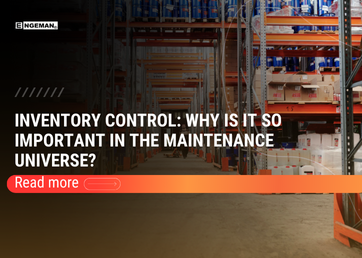With the high competitiveness of the market, some factors such as availability, reliability, and cost reduction have come to be seen with special attention in the industry. In order to these factors to be achieved and for the company to be more competitive on the market, the maintenance department has been seen as a strategic part by managers. As a result, the role of maintenance is no longer just to “put out fires”.
In this way, the Failure Mode and Effect Analysis or FMEA achieves more attention in maintenance management. It is a strategic tool used to identify abnormalities and their causes and effects.
In this article, we have gathered some basic concepts about FMEA meaning and the application and use of this tool in maintenance. Let’s check it!
What is FMEA?
The acronym FMEA means “Failure Mode and Effect Analysis” and it is a standard that began in the 1980s, as a standard for military operations, documented in MIL-STD-1629A.
Developed to analyze possible failures, severity and occurrence within a process, system, or product, with the aim of scheduling, optimizing, and improving, as well as avoiding and treating the failure consequences.
How do you use FMEA?
Having in mind that its main goal is the search for constant improvement, FMEA application is very comprehensive, being divided into several categories, such as products, processes, systems, services, and software. Another point that is worth mentioning and which is usually ignored or unknown, is that the application of this standard is a long, constant, and cyclical process.
In many cases, the application fails due to a lack of commitment or discouragement in continuing to update the documents and processes already mapped. It is of paramount importance that the documents produced are reviewed, improved and always updated, with the purpose of eliminating or reducing failures and their consequences, in addition to predicting and treating new failures, inherent to the evolution of the production process.
Once this concept is clarified, the first step is to organize a team and define the role of each participant. In this way, it is possible to diversify and increase the view of processes and failures, combining the experience and technical knowledge of each team member with the organization’s processes and routines and the possible consequences of each failure.
Secondly, it is necessary to identify the possible modes of failure. Using a production line as an example, it is necessary to identify which equipment, components and subcomponents and their possible failures, listing each one of them in degree of importance. When identifying failures, it is necessary to analyze the risks of each failure mode, assigning a value on a scale of 1 to 10 to three pillars:
- Severity – How serious is the problem?
- Probability – What is the chance of it happening?
- Detectability – How easy or likely is the failure to be detected?
Scores will be given from lowest to highest in severity and probability items and from highest to lowest in detectability. Therefore, we can conclude that the lower the severity and probability, the better and the greater the chance of detecting a failure, the better. See the following tables:
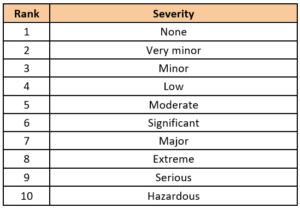
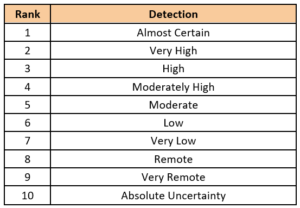
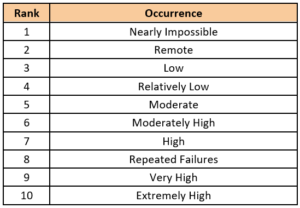
To calculate the risk preference number (RPN), we multiply the score assigned to each item. The higher the risk preference number, the more attention and control is needed to avoid or improve the process in order to avoid that failure. In this example we can see a table regarding the deployment of the vehicle airbag:
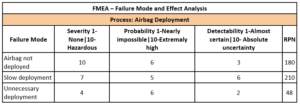
It is necessary to analyze whether the failures and mapped processes are important and whether their control does not require an unnecessary cost to the company. In some situations, corrective maintenance is more feasible than preventive maintenance, due to several factors, such as labor cost, displacement, or difficulty in performing it. In some cases, it is more feasible to leave equipment or process running until failure occurs than to step in with preventive or predictive maintenance. Identifying these cases and addressing them in FMEA documentation will also bring positive results for the company.
Having in mind that FMEA goal is constant quality and improvement, once RPN is calculated, we can define the priority and establish processes in order to avoid or minimize failure and its risk. It is necessary to keep in mind that the process must be cyclical, with the reviewing goal, changing and including news processes.
What is the FMEA for maintenance?
During the preparation of the FMEA detailing documents, one of the essential points remains the elaboration of actions to prevent or correct the failure. In both cases, the procedures must be included in the FMEA documentation and their execution must be recorded according to scheduling and performance of each procedure. The action plan creation and maintenance plan that will be executed to ensure the process integrity, equipment or failure must undergo constant improvements, with the aim of encompassing the improvements developed over time.
Remember that the FMEA focus represents the constant improvement of quality and prevention, in whatever area it is applied. The execution and activities of the outlined activities will ensure greater reliability and safety in the production process, in the development of new products or systems. Its application brings several benefits and should be applied together with other methodologies, reducing costs, eliminating useless or expensive processes that do not bring a benefit to the company.
The FMEA application brings an extraordinary gain, enabling the company to organize, analyze and better understand its production process, allowing the possibility of reviewing not only maintenance routines, but the process as a whole, seeking to improve each stage of the production chain. Although its deployment is extended and costly, the time reduction, effort and risk reduction already justify the methodology adoption.
And finally, a question to reflect on: Do you not have time because your number of correctives is high, or your number of correctives is high because you do not have time to schedule and plan your maintenance?
Always stay well informed about maintenance management and control by following our social networks: Facebook, Instagram and Telegram!


